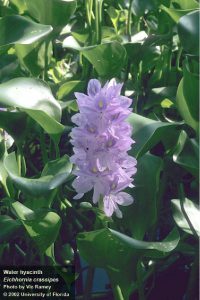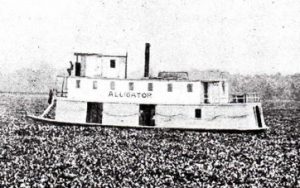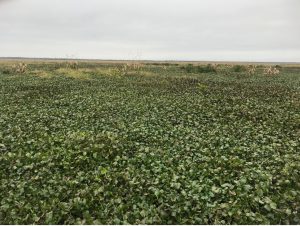By: Dr. Jason Ferrell, UF/IFAS Center for Aquatic and Invasive Plants Director

Waterhyacinth is a free-floating plant that produces a showy and very attractive blue/purple flower. As they bunch together and bloom, it provides a picturesque setting for any water garden. At least that was the thought when these plants were given away to attendees of the 1884 World’s Fair in New Orleans, LA. Some of these plants made their way back to Florida and found their way into the St. Johns River. Before long, the river was choked, river commerce all but stopped, and flooding began to occur. Waterhyacinth continued to spread and eventually found themselves in almost every river, creek, canal, and lake in Florida.
The Rivers and Harbors act of 1899 was a piece of federal legislation that tasked the US Army Corps of Engineers to maintain open navigation through our national river systems – this naturally included waterhyacinth management in Florida. Some of the best and brightest American engineers started developing dredges, conveyers, and harvesters to remove these plants. Thousands of tons of waterhyacinth were removed each year, but since this invasive plant lacked any natural enemies to slow its growth and proliferation, it continued to spread despite these massive efforts.

It was not until the 1950’s and the introduction of the herbicide 2,4-D that Florida started getting ahead of this floating menace. Herbicides were much cheaper than harvesting while also allowing several hundred acres to be managed daily. This new tool, coupled with harvesters, could finally remove plants faster than the plants reproduce. These techniques were further aided with the release of biocontrol insects. This has allowed Florida to attack this plant with chemical, mechanical, and biocontrol methods to keep it at bay.

So, does this mean waterhyacinth is a yesterday problem we have outgrown? Absolutely not! Though we have more tools now to manage this plant, waterhyacinth has not changed one bit since its introduction in the 1880’s. The plant is still a super-aggressive invasive that loves to take over. If you let your guard down, it will make you regret it.
This story serves as a reminder to all Floridians – please do not release non-native plants into the environment. These plants do not belong here and often cause a host of problems and should be considered a biological pollutant. Also, we need to remember that these plants, once released, do not become tame with time. They are destructive and expensive. The only way to keep our waterways open and clear is to manage them year-round and never expect them to play nice.
This blog post was written by Dr. Jason Ferrell, UF/IFAS CAIP director and professor. Questions or comments can be sent to the UF/IFAS CAIP communications manager at caip@ifas.ufl.edu. Follow UF/IFAS CAIP on Instagram, Facebook, and Twitter. Subscribe for more blogs like this one.
UF/IFAS Center for Aquatic and Invasive Plants. Turning Science Into Solutions.
Did you find this post helpful? Click the heart below!
 0
0
